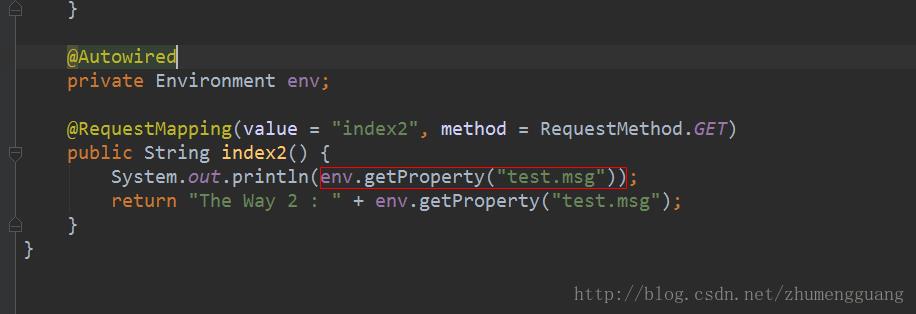springBoot 读取yml 配置文件的三种方式 (包含以及非component下)
Posted 极光雨雨
tags:
篇首语:本文由小常识网(cha138.com)小编为大家整理,主要介绍了springBoot 读取yml 配置文件的三种方式 (包含以及非component下)相关的知识,希望对你有一定的参考价值。
遇到的问题
一般spring Boot 环境中可以直接通过 @Value 方式相当于读取注入的方式直接获得配置文件中的值,但实际上当处于非标准的 controller ,service 或 component 注解下的文件想要读取时,由于不是 properties 也不能直接通过properties 的方式直接加载,直接读取文件流也不知道是否可行,查找部分资料后找到了解决方式,下面做下记录
标准读取方式一(一般controller 以及 service 等包含component 可以直接获取spring 中的值)
@Value
即类似于
@Service
@Slf4j
public class AutoTestServiceImpl implements AutoTestService
@Value("$autotest.server.url")
private String baseUrl;
........
application.yml 或者 application.properties 配置文件中如下
yml
autotest:
server:
url: http://localhost:8080
properties
autotest.server.url=http://localhost:8080
spring的 Environment 类
SpringBoot 可以使用 @Autowired 注解注入 Environment 对象
SpringBoot 会将配置文件中所有的数据封装到 Environment 对象中,使用只需要通过调用 Environment 对象的getProperty(String name) 方法即可获取
例如上面 yml 或 properties 中的值可以通过
@RestController
@RequestMapping("/testCon")
public class BookController
@Autowired
private Environment env;
@GetMapping("/id")
public void gettest(@PathVariable Integer id)
System.out.println(env.getProperty("autotest.server.url"));
非标准 controller 或者 service 等文件中无法直接通过 @autowired 方式获取 Environment 时的处理方式
这里可以直接通过 spring 原有的 ApplicationContext 来获取该对象从而实现从 yml 获取数据,properties 当然也可以,但properties 可以通过直接加载 properties 的方式获取值,相对来说更容易一点
实例如下:
这里先要定义一个从 spring环境上下文 获取已放到容器实体的工具类,这个是 一般的spring都支持的,也是常用的工具之一
工具定义如下:
import org.springframework.beans.BeansException;
import org.springframework.context.ApplicationContext;
import org.springframework.context.ApplicationContextAware;
import org.springframework.stereotype.Component;
import java.util.Collection;
@Component
public final class ToolSpring implements ApplicationContextAware
private static ApplicationContext applicationContext = null;
public static Object getBean(String name)
return getApplicationContext().getBean(name);
public static ApplicationContext getApplicationContext()
return applicationContext;
public static <T> T getBean(Class<T> clazz)
return getApplicationContext().getBean(clazz);
@Override
public void setApplicationContext(ApplicationContext applicationContext) throws BeansException
if (ToolSpring.applicationContext == null)
ToolSpring.applicationContext = applicationContext;
public static <T> Collection<T> getBeansOfType(Class<T> clazz)
return applicationContext.getBeansOfType(clazz).values();
通过 实现 ApplicationContextAware 来获取spring 上下文对象,以此获取容器中的 Bean
实际使用时一般也用于无法直接通过 @Autowired 或 @Resource 注入的属性,都可以通过这种方式获取,由于 Environment 为springBoot 自身提供的 Bean 故可以获取到
如下:
这里我在初始化时通过该方式给予赋值
public class MyTest
private String baseUrl;
Environment bean = ToolSpring.getBean(Environment.class);
baseUrl = bean.getProperty("autotest.server.url");
// 此时下面的其他方法即可引用 baseUrl
.........................
但是: 这种通过 Environment 获取数据的方式并不常用,非必要可以不用,毕竟加载了项目配置文件内的所有数据
自定义对象封装数据
这种方式没有实际使用过,但也记录一下
SpringBoot 也提供了将配置文件中的数据封装到自定义实体类对象中的方式
- 为了将实体类 bean 的创建交给 Spring 管理 在自定义类上添加 @Component 注解
- 使用 @ConfigurationProperties 注解表示加载配置文件,在该注解中也可以使用 prefix 属性指定只加载指定前缀的数据
- 在需要使用该类的controller, Service等中进行注入
例如:
import lombok.Data;
import org.springframework.boot.context.properties.ConfigurationProperties;
import org.springframework.stereotype.Component;
@Data
@Component
@ConfigurationProperties(prefix = "auto.message")
public class WxTemplateProperties
private String id;
private String akId;
如果没有使用过 lombok 的 @Data 可以手动引入一下,效果仅仅是自动生成 get set 方法,如果不需要也可以手动生成 get set 有快捷键也很容易。
如果
添加 @ConfigurationProperties 出现警告,则可以添加依赖
<dependency>
<groupId>org.springframework.boot</groupId>
<artifactId>spring-boot-configuration-processor</artifactId>
<optional>true</optional>
</dependency>
解决
之后改类可以通过 @Autowired 等方式注入后使用。
springboot读取yml配置文件
springboot 读取 yml 配置的几种方式
前言:在springboot 项目中一般默认的配置文件是application.properties,但是实际项目中我们一般会使用application.yml 文件,下面就介绍一下在springboot 中读取 yml 配置的几种方式.
yml 文件规则
- yml文件的好处,天然的树状结构,一目了然,实质上跟properties是差不多的。
- 不支持tab缩进
- 可以使用 "-小写字母" 或 "_小写字母"来 代替 "大写字母",如 userName 与 user-name ,user_name 含义是一样的
key: value 格式书写
key 后面跟着冒号,再后面跟着一个空格,然后是值
几种数据格式的表示方式
- 1.普通的值(数字,字符串,布尔)
- 2.对象、Map (属性和值) (键值对)
- 3.数组 (List、Set)
普通的值(数字,字符串,布尔)
直接就是 key: value ,如:
age: 18
name: mysgk
注:
字符串默认不用加上单引号或者双引号;
"":双引号;不会转义字符串里面的特殊字符;特殊字符会作为本身想表示的意思
name: "zhangsan \\n lisi":输出;zhangsan 换行 lisi
'':单引号;会转义特殊字符,特殊字符最终只是一个普通的字符串数据
name: ‘zhangsan \\n lisi’:输出;zhangsan \\n lisi
对象、Map(属性和值)(键值对)
对象还是k: v的方式
k: v:在下一行来写对象的属性和值的关系;注意缩进(不支持tab,使用空格),如:
person:
age: 18
name: mysgk
数组(List、Set)
用- 值表示数组中的一个元素,如:
hands:
- left
- right
第一种读取方式@value
如果我们只需要配置文件中的一两个值,@Value 是最简单方便的方式.
server:
port: 8081
我们在代码中可以这样取值
@Value("$server.port")
public String port;
注:此处的prot 所在的类需要是一个组件,如果是实体类需要加上@Component
第二种读取方式@ConfigurationProperties
如果需要一个JavaBean 来专门映射配置的话,我们一般会使用@ConfigurationProperties来读取.
student:
age: 18
name: mysgk
javabean:
@Component
@ConfigurationProperties(prefix = "student")
public class Student
private String name;
private Integer age;
public String getName()
return name;
public void setName(String name)
this.name = name;
public Integer getAge()
return age;
public void setAge(Integer age)
this.age = age;
@Override
public String toString()
return "Student" +
"name='" + name + '\\'' +
", age=" + age +
'';
使用@ConfigurationProperties,需要配置一个prefix (前缀) 参数, 即写上 key 就可以了.
第三种读取方式@Environment
这种方法好像用的比较少,基本没用过...
test:
msg: aaa
代码:
@Autowired
private Environment env
@RequestMapping(value = "index2", method = RequestMethod.GET)
public String index2()
System.out.println(env.getProperty("test.msg"));
return "The Way 2 : "+ env.getProperty("test.msg");

以上是关于springBoot 读取yml 配置文件的三种方式 (包含以及非component下)的主要内容,如果未能解决你的问题,请参考以下文章